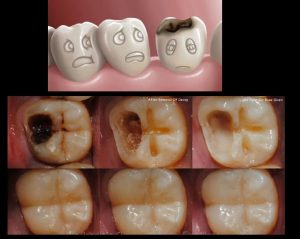The quackery of -traditional- Dentistry.
Drilling and filling, wisdom tooth removal, flossing.
What Your Dentist Won’t Tell You………Bacteria produce an acid that can wear away the enamel [outer surface] of your teeth, gradually working their way inside, and digging out a hole [cavity].
Teeth are basically bone. As we all know, bones have the ability to repair themselves when damaged.
Thus, the idea of paying money to a dentist, to drill into a tooth, and insert a “filling” into a cavity, should seem somewhat counter to logic and reason. In short, drilling, filling, and capping, should be unnecessary. Teeth are comprised of minerals, such as calcium, phosphate, and fluoride. The acids produced by bacteria can ‘demineralize” the inner portion of a tooth, resulting in a hole, called a “cavity”.
.
There are thus, 2 mechanisms to address to heal a cavity
1— neutralize the acid produced by the bacteria, and/or kill the bacteria
2— provide the minerals necessary for the tooth to rebuild itself by filling-in the cavity [calcium, phosphate, and fluoride]
.
The 2 major purposes of brushing your teeth are……
1— remove bacteria in the form of “plaque” from your teeth
2— remove food particles from your teeth and mouth, since bacteria feed on the carbohydrates
TheETG teeth cavity reversal —–
.
“…..the radical surgical approach prevailing in the 1960s has generally continued despite overwhelming research outputs in caries prevention and treatment in the succeeding half century .”
W.Evans, et al
The Caries Management System: are preventive effects sustained postclinical trial?
Community Dentistry And Oral Epidemiology — Volume 44 — 2016 — page 188
.
“It’s unnecessary for patients to have fillings because they’re not required in many cases of dental decay….”
“This research signals the need for a major shift in the way tooth decay is managed by dentists.”
[Wendell Evans of the University of Sydney]
.
“….the gap between what is occurring in clinical practice and what published research findings suggest….”
“Dentists reported a medium-range concordance between practice and published evidence.”
“Efforts to bring research findings into routine practice are needed….”
W.E. Norton, et al
Concordance between clinical practice and published evidence: Findings from The National Dental Practice-Based Research Network
Journal Of The American Dental Association — Volume 145 #1 — January 2014 — page 22 – 31
.
“……majority of available studies fail to demonstrate that flossing is generally effective in plaque removal…..2015 review cites “inconsistent/weak evidence” for flossing and a “lack of efficacy…….a dental magazine stated that any benefit would be so minute it might not be noticed by users. ”
[CBSNews, A big problem with flossing — Auguste 2, 2016]


“This laboratory study investigated the whitening effect of toothbrushing with sodium bicarbonate-based dentifrices compared with standard dentifrices that do not contain sodium bicarbonate.”
“Six dentifrices and a distilled water control were tested for their ability to whiten teeth with intrinsic stain.”
“The dentifrices contained different abrasive systems: (1) 45% NaHCO3; (2) 65% NaHCO3 (Arm and Hammer Dental Care); (3) 94% NaHCO3; (4) 94% NaHCO3 + 1.5% H2O2; (5) silica (Crest Regular Toothpaste); and (6) dicalcium phosphate (Colgate Regular Toothpaste).”
“Measurements were taken on a total of 12 teeth per test dentifrice before treatment, and after 30, 60, 90 and 120 minutes of mechanical toothbrushing.”
“Compared to baseline tooth color, all four sodium bicarbonate-based dentifrices were significantly effective in removing the yellow intrinsic tooth stain, while the water control, silica dentifrice, and dicalcium phosphate dentifrice demonstrated no significant change.”
“Between-group comparisons showed that the four dentifrices containing sodium bicarbonate were significantly more effective than the water and dicalcium phosphate dentifrice groups.”
“The commercial dentifrice containing 65% sodium bicarbonate was also more effective than the commercial silica dentifrice. Although continued toothbrushing from 30 to 120 minutes resulted in additional stain removal, most of the tooth whitening by the sodium bicarbonate-based dentifrices occurred in the first 30 minutes of brushing.”
“In the studies conducted, dentifrices containing high concentrations of sodium bicarbonate were more effective at removing intrinsic tooth stain than dentifrices that do not contain sodium bicarbonate.”
Laboratory assessment of tooth whitening by sodium bicarbonate dentifrices
Journal Of Clinical Dentistry….Volume 9 #3….1998….page 72 – 75
“The effect of twice-daily brushing with one of three different dentifrices (Arm & Hammer Dental Care, Arm & Hammer Dental Care Extra Whitening, Crest) on stain removal and tooth whitening was examined in 115 volunteers over a period of 12 weeks.”
“The facial surfaces of 12 anterior teeth were assessed for stain using a published, modified version of a standard stain index. Whiteness was measured on teeth 8 and 9 using a single Vita Lumin-Vaccum Shade Guide for consistency.”
“Arm & Hammer Dental Care Extra Whitening formula was found to be significantly better than Crest at removing naturally occurring extrinsic stain. The difference between Arm & Hammer Dental Care Extra Whitening and Crest became significant after two weeks of use, and remained intact during the balance of the study….”
“The study also found that Arm & Hammer Dental Care produced a significant increase in tooth whiteness by week 12, whereas Crest showed no such increase at any time during the study.”
“These results suggest that the two Arm & Hammer Baking Soda products are more effective in reducing stain and increasing whiteness than the standard silica-based dentifrice. Their effectiveness is not related to abrasivity since they are less abrasive to tooth enamel than the silica-based product tested.”
A longitudinal comparison of tooth whitening resulting from dentifrice use
Journal Of Clinical Dentistry….Volume 9 #3….1998….page 67 – 71


